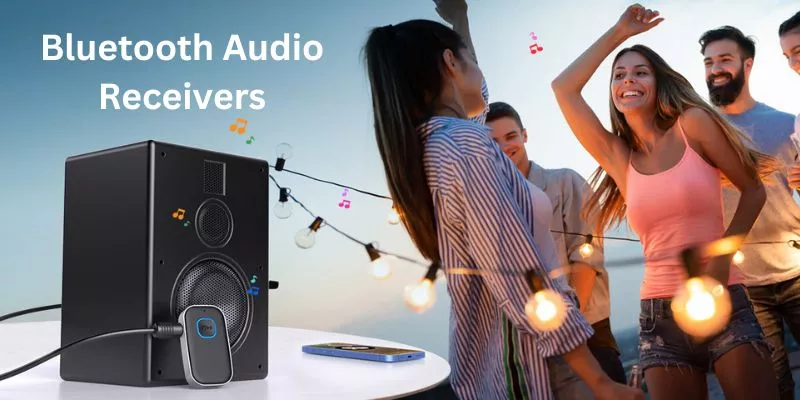Bluetooth audio receivers have become indispensable in the world of modern audio. Whether you’re aiming to revamp your car’s sound system, upgrade your multi-channel home theatre setup, or simply enjoy wireless music on the go, these devices offer a hassle-free way to enhance your audio experience. In this comprehensive guide, we’ll explore the realm of Bluetooth audio receivers, uncover their advantages, delve into crucial features to consider, and provide expert guidance to help you make an educated decision. If you are looking for the best products try to read our best recommended Bluetooth audio receivers.

Table of Contents
What are Bluetooth Audio Receivers?
Bluetooth audio receivers serve as wireless conduits between your audio source (such as a smartphone, tablet, or laptop) and your audio output devices (speakers or headphones). On the other hand, Bluetooth audio transmitters allow non-Bluetooth devices to transmit audio wirelessly to Bluetooth-enabled speakers or headphones.
How Bluetooth Audio Receivers Work?

Bluetooth audio receivers work by receiving a wireless signal from your phone or other device and converting it into an analog audio signal that can be played through your speakers. They use Bluetooth technology to establish a wireless connection between your device and the receiver. Once the connection is established, you can stream music from your device to the receiver and enjoy high-quality audio without any wires. A Bluetooth audio receiver converts Bluetooth signals to audio output, while a Bluetooth audio adapter adds Bluetooth functionality to non-Bluetooth audio sources.
Advantages of Using Bluetooth Audio Receivers
- Improved Audio Quality: Bluetooth receivers and transmitters support advanced audio codecs like aptX and AAC, delivering near-CD quality sound.
- Wireless Convenience: Say goodbye to tangled wires. Bluetooth technology allows you to stream audio wirelessly.
- Compatibility with Various Devices: Bluetooth audio receivers work with a wide range of devices, from smartphones and laptops to older audio systems.
- Streaming Capabilities: Most Bluetooth devices support music streaming services like Spotify, Apple Music, and more.
Types of Bluetooth Audio Receiver
Bluetooth audio receivers come in various types based on the technology they use and their use cases. Here are different types of Bluetooth audio receivers categorized by technology and use cases:
Based on Technology:

- Basic Bluetooth Audio Receivers: These are the standard Bluetooth receivers that use Bluetooth technology to stream audio wirelessly from your source device to your speakers or headphones. They are versatile and can be used in various settings.
- Bluetooth 5.0 and Above Receivers: These receivers use the latest Bluetooth technology (e.g., Bluetooth 5.0, 5.1, 5.2) to provide improved range, stability, and faster data transfer rates. They are ideal for users who want a reliable and high-quality wireless audio experience.
- AptX and AAC Compatible Receivers: These receivers support advanced audio codecs like aptX and AAC, which deliver higher audio quality compared to standard Bluetooth audio. They are suitable for audiophiles who prioritize sound fidelity.
- LDAC and Hi-Res Audio Receivers: LDAC is a high-resolution audio codec that offers exceptional sound quality. Receivers with LDAC support are perfect for users who demand the best audio experience possible.
Based on Use Cases:

- Portable Bluetooth Audio Receivers: These small, battery-powered receivers are designed for on-the-go use. They are perfect for upgrading the audio quality of your smartphone, tablet, or laptop when you’re traveling or outdoors.
- Home Bluetooth Audio Receivers: Home receivers are designed to connect to your home audio system, stereo, or home theater setup. They often have more connectivity options and support multi-room audio for a seamless home entertainment experience.
- Car Bluetooth Audio Receivers: Car receivers are specially designed for in-car use. They often come with hands-free calling features, touchscreen controls, and compatibility with car audio systems for improved driving comfort and entertainment.
- Bluetooth Transmitters and Receivers (2-in-1): These versatile devices can function as both Bluetooth transmitters (send audio from non-Bluetooth devices to Bluetooth speakers or headphones) and Bluetooth receivers (receive audio from Bluetooth-enabled devices and play it through non-Bluetooth speakers or audio systems).
- Bluetooth Receiver with Built-in Amplifier: These receivers have a built-in amplifier and are suitable for powering passive speakers directly. They are ideal for users looking to create a compact, high-quality audio setup.
- Multi-Connection Bluetooth Receivers: These receivers can connect to multiple source devices simultaneously. They are handy for households or offices where several people want to share the same audio system.
- Gaming Bluetooth Audio Receivers: Designed for gamers, these receivers prioritize low latency audio transmission to ensure that the audio and video stay in sync during gaming sessions. They often have dedicated gaming modes.
- Wireless Audio Adapters for TV: These receivers are specifically designed to connect to your TV and transmit audio wirelessly to Bluetooth headphones or speakers. They are perfect for late-night TV watching without disturbing others.
By considering both the technology and use case, you can choose the Bluetooth audio receiver that best suits your audio needs and preferences. Whether you’re enhancing your music listening experience, upgrading your home theater, or gaming, there’s a Bluetooth audio receiver designed to meet your requirements
Setting Up and Using Your Bluetooth Audio Receiver
Once you’ve chosen the perfect Bluetooth audio receiver, it’s time to set it up and enjoy wireless audio. Follow these steps for a hassle-free experience

Step 1: Unbox and Inspect
Start by carefully unboxing your Bluetooth audio receiver. Inspect it for any physical damage, missing accessories, or loose components. Make sure you have all the necessary components mentioned in the user manual.
Step 2: Read the Manual
Every Bluetooth audio receiver may have unique setup instructions and features. Take a moment to read the user manual provided with your device. This manual will provide essential information on setup, pairing, and troubleshooting specific to your receiver model.
Step 3: Connect Power
If your Bluetooth audio receiver requires power, connect it to a power source. This could involve plugging it into a wall outlet, using a USB power source, or installing batteries if it’s a portable model. Ensure the receiver has sufficient power to function properly.
Step 4: Pairing with Your Device
Pairing your Bluetooth audio receiver with your source device (e.g., smartphone, tablet, or laptop) is a straightforward process:
a. Activate Bluetooth on Your Source Device
Go to the Bluetooth settings on your source device and turn it on. Make sure your device is discoverable.
b. Put the Receiver in Pairing Mode
Follow the instructions in the user manual to put your Bluetooth receiver in pairing mode. Typically, this involves holding down a specific button or combination of buttons until you see a blinking LED indicator.
c. Discover and Connect
On your source device, search for available Bluetooth devices. You should see your Bluetooth audio receiver listed. Select it to initiate the pairing process.
d. Enter a Passcode (if required)
In some cases, your receiver might prompt you to enter a passcode for added security. Refer to the user manual for the correct passcode, if necessary.
e. Successful Pairing Once the pairing is successful, you’ll see a notification on both your source device and the receiver. Your Bluetooth audio receiver is now ready to use
Troubleshooting Common Issues
While Bluetooth pairing is usually straightforward, you might encounter some common issues:
Pairing Failures: If the devices don’t pair successfully, ensure they are within the specified range and in pairing mode. Restart both devices and try again.
Audio Dropouts: If you experience audio dropouts, check for interference from other wireless devices or walls obstructing the signal. Reposition the receiver for a stronger connection.
No Sound: If there’s no sound, verify that the volume on both your source device and the Bluetooth receiver is turned up. Ensure the correct input source is selected on your audio system.
Device Compatibility: Confirm that your source device is compatible with the Bluetooth audio receiver, and the receiver supports the required audio codecs.
Tips for Optimizing Audio Quality
To get the best audio experience from your Bluetooth audio receiver, consider the following tips:
Audio Codecs: Use high-quality audio codecs like aptX or AAC if your devices support them for improved sound quality.
Signal Strength: Keep your source device within the recommended Bluetooth range to avoid signal interruptions.
Line of Sight: Position your receiver and source device with a clear line of sight to minimize signal interference.
Audio Source: Ensure your source device is playing high-quality audio files or streaming content from a reliable source for the best sound.
EQ Settings: Experiment with the EQ settings on your Bluetooth receiver to tailor the audio to your preferences.
With these steps, you can set up your Bluetooth audio receiver with ease, troubleshoot common issues, and optimize the audio quality for a superior wireless listening experience. Enjoy the freedom of wireless audio without compromising on sound quality.
Conclusion
Bluetooth audio quality is a multifaceted topic influenced by various factors. The quality of Bluetooth audio has significantly improved over time, with advancements in audio codecs and Bluetooth versions. The choice of the best Bluetooth audio quality primarily depends on the codecs, equipment, and devices you’re using. Advanced audio codecs like aptX, aptX HD, LDAC, and AAC offer higher audio quality compared to the basic SBC codec. These codecs, especially LDAC and aptX HD, can provide near-lossless audio quality, making them suitable for audiophiles and those seeking top-notch Bluetooth sound.
The version of Bluetooth also plays a role in audio quality. Bluetooth 5.0 and newer versions have enhanced data transfer rates and more reliable connections, contributing to improved audio quality. However, it’s essential to note that Bluetooth still has some limitations compared to wired connections. While it can deliver high-quality sound, it may not match the audio fidelity achieved through a wired setup.
Bluetooth receivers can be valuable tools for enhancing your audio experience. They allow you to upgrade non-Bluetooth devices by converting Bluetooth signals into analog or digital audio output. Bluetooth receivers are particularly useful for those who want to modernize their older audio systems or wired headphones. When choosing a Bluetooth receiver or adapter, consider factors like compatibility with your devices, supported codecs, and the quality of the built-in DAC. Higher-end receivers often offer better audio quality, especially when paired with high-quality codecs and audio equipment.
While Bluetooth has made significant strides in audio quality, it’s essential to remember that factors like source material, the quality of your headphones or speakers, and your listening environment also influence the overall audio experience. To make the most of Bluetooth audio, use high-quality audio files, invest in best speakers or headphones, and optimize audio settings on your devices. Additionally, advancements in Bluetooth technology continue to push the boundaries of wireless audio quality, making it an increasingly viable option for even the most discerning audiophiles.




Great goods from you, man. I’ve take into account your stuff previous to and you’re simply extremely magnificent. I really like what you have acquired here, really like what you are saying and the way by which you are saying it. You’re making it enjoyable and you still take care of to stay it smart. I can’t wait to read much more from you. That is really a tremendous site.
Hi there mates, its enormous post about teachingand completely explained,
keep it up all the time.